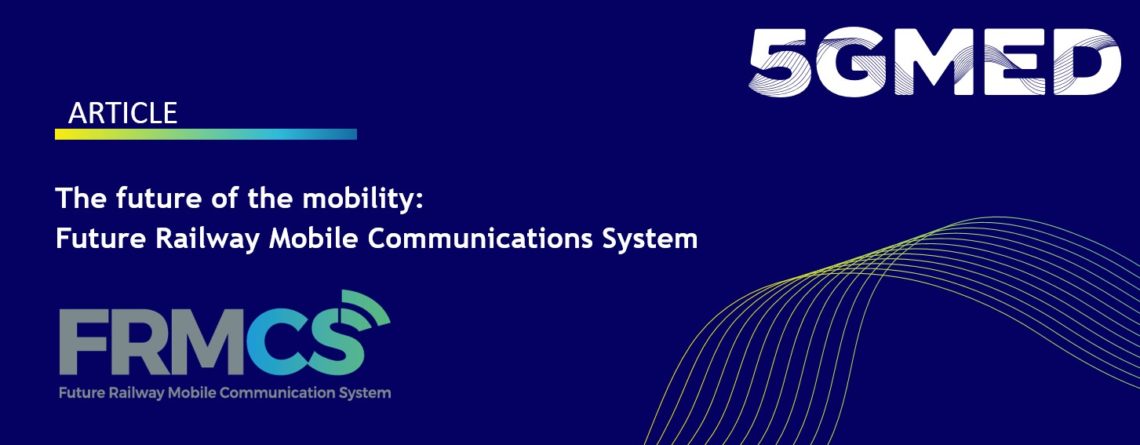The future of the mobility: Future Railway Mobile Communications System
H2020 European Projects, 5GMed, aims to contribute to evolving a sustainable 5G deployment model for future mobility in the Mediterranean Cross-Border Corridor. One particular case will work on the transition of a commercial high-speed train, TGV, provided by SNCF, between ADIF in Spain and SNCF in France: advanced applications in cross-border situations.
Time is changing and 5G deployment is clearly on the path of revolutionizing the entire society. Most of the sectors have to prepare for their technology transition to get on board of the new challenges that are coming. The Railway sector and specifically the Global System for Mobile Communications – Railway (GSM-R) technology are also facing some necessary improvements to deal with the high volume of data transmitted that concerns the infrastructure as much as the on-board use and the evolved telecommunication requirements such as low latency and very high reliability. For that purpose, since 2014, the International Union of Railways (UIC) has been working on the deployment of a new standardized system called the Future Railway Mobile Communication System (FRMCS) with objectives such as reaching ultra-low latency and ultra-high reliability.
GSM-R, the obsolescence of a success story
Digital mutation in the railway sector has been operated since the nineties when implementing the GSM-R, a “successful digital radio system used by railways around the world” in the words of Dan Mandoc (Head of FRMCS) and Jean-Michel Evanghelou (Deputy Director of Rail Systems and Head of Telecom, Signalling and Digital Applications) covering more than 130,000 km of lines, providing 2G+ connectivity, improving safety through the Railway Emergency Call system and enabling the European Rail Traffic Management System (ERTMS).
The efficacity of GSM-R does not have to be proven anymore. Although it has the capability to address the railway’s needs for train operation, the system is reaching its end and needs some adjustments. According to the Policy Officer of Rail Digitalization at the European Commission, Carlos de Grandis:
“Actually, the current strains in spectrum capacity for GSM-R are mostly linked to the problem of cross-border coordination and large use of voice communication, linked to old operational rules, logics and habits and not relying on in-cabin signalling (the impact of both phenomena being worsened by the circuit-switching logic).” (The Global Railway Review)
Meanwhile, it will be deployed and be operative until 2030, FRMCS will fulfil the lack of capacity to transmit the volumes of data needed from today on. Among the challenges that involves the upgrade of GSM-R to 5G, the technology deployed transition and adaption aspects have to be taken into account along with the need of trained operators but most important, FRMCS will have to be future proof.
The objective of FRMCS: to be a worldwide standard
The new system, which will provide voice and data applications but also performance applications, will have its first version available by 2025. The UIC planes two phases of the worldwide environment project, based on the objective to strengthen harmonized Railway radio communications systems in Europe, by “keeping the pace with the technological advance, while preserving interoperability and protecting Railways investments” with the necessity to evolve in a “relevant world standardization bodies, notably: ETSI, 3GPP and ITU”.
The 5G technology is the key for the data to be connected in real time to provide Infotainment services such as multimedia passenger information systems and streaming services. Other technologies such as sensors could be employed for monitoring tracks, rolling stock, power systems and environmental conditions. Maintenance requirements will be predicted with the use of Internet of Things data as much as the potential incidents at rail crossings.
5GMed and 5GRAIL projects on tracks
5GMed will demonstrate advanced Cooperative Connected and Automated Mobility (CCAM) and Future Railway Mobile Communications System services (FRMCS) along the “Figueres-Perpignan” cross border corridor between Spain and France enabled by a multi-stakeholder compute and network infrastructure deployed by MNOs, neutral hosts, and road and rail operators, based on 5G and offering support for AI functions. The project, which brings together institutions and companies from different sectors, focuses on four specific use cases: autonomous driving, advanced traffic management, the continuity of commercial services on the railway and infotainment for autonomous cars and railways. Regarding specifically the Railway sector, the pilot project will develop services to support the digitalization of the railway, with the monitoring of trains and the railway infrastructure, in addition to improving the passenger experience.
The 5GRAIL project aims to validate the first FRMCS specifications by developing and testing prototypes for the FRMCS that will be experimented with in laboratories and in real track conditions.
Marjorie Grassler, communication executive at Mobile World Capital Barcelona
More info
5gmed.eu
Follows us on social media
Linkedin
Twitter


